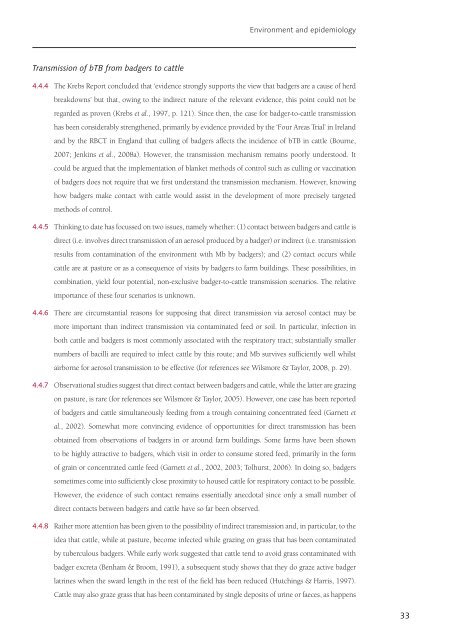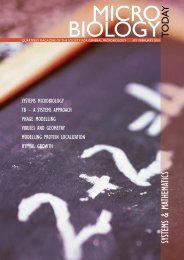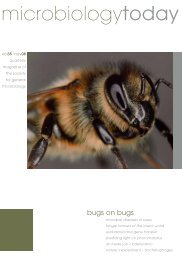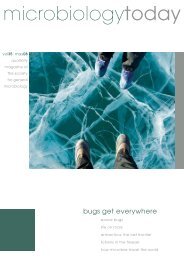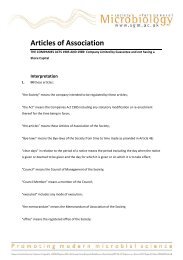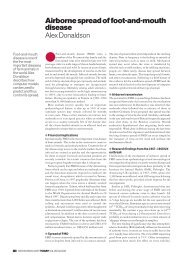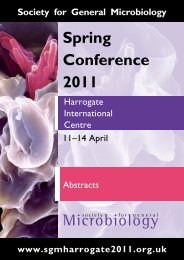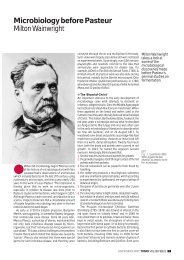final report - ARCHIVE: Defra
final report - ARCHIVE: Defra
final report - ARCHIVE: Defra
You also want an ePaper? Increase the reach of your titles
YUMPU automatically turns print PDFs into web optimized ePapers that Google loves.
Environment and epidemiology<br />
Transmission of bTB from badgers to cattle<br />
4.4.4 The Krebs Report concluded that ‘evidence strongly supports the view that badgers are a cause of herd<br />
breakdowns’ but that, owing to the indirect nature of the relevant evidence, this point could not be<br />
regarded as proven (Krebs et al., 1997, p. 121). Since then, the case for badger-to-cattle transmission<br />
has been considerably strengthened, primarily by evidence provided by the ‘Four Areas Trial’ in Ireland<br />
and by the RBCT in England that culling of badgers affects the incidence of bTB in cattle (Bourne,<br />
2007; Jenkins et al., 2008a). However, the transmission mechanism remains poorly understood. It<br />
could be argued that the implementation of blanket methods of control such as culling or vaccination<br />
of badgers does not require that we first understand the transmission mechanism. However, knowing<br />
how badgers make contact with cattle would assist in the development of more precisely targeted<br />
methods of control.<br />
4.4.5 Thinking to date has focussed on two issues, namely whether: (1) contact between badgers and cattle is<br />
direct (i.e. involves direct transmission of an aerosol produced by a badger) or indirect (i.e. transmission<br />
results from contamination of the environment with Mb by badgers); and (2) contact occurs while<br />
cattle are at pasture or as a consequence of visits by badgers to farm buildings. These possibilities, in<br />
combination, yield four potential, non-exclusive badger-to-cattle transmission scenarios. The relative<br />
importance of these four scenarios is unknown.<br />
4.4.6 There are circumstantial reasons for supposing that direct transmission via aerosol contact may be<br />
more important than indirect transmission via contaminated feed or soil. In particular, infection in<br />
both cattle and badgers is most commonly associated with the respiratory tract; substantially smaller<br />
numbers of bacilli are required to infect cattle by this route; and Mb survives sufficiently well whilst<br />
airborne for aerosol transmission to be effective (for references see Wilsmore & Taylor, 2008, p. 29).<br />
4.4.7 Observational studies suggest that direct contact between badgers and cattle, while the latter are grazing<br />
on pasture, is rare (for references see Wilsmore & Taylor, 2005). However, one case has been <strong>report</strong>ed<br />
of badgers and cattle simultaneously feeding from a trough containing concentrated feed (Garnett et<br />
al., 2002). Somewhat more convincing evidence of opportunities for direct transmission has been<br />
obtained from observations of badgers in or around farm buildings. Some farms have been shown<br />
to be highly attractive to badgers, which visit in order to consume stored feed, primarily in the form<br />
of grain or concentrated cattle feed (Garnett et al., 2002, 2003; Tolhurst, 2006). In doing so, badgers<br />
sometimes come into sufficiently close proximity to housed cattle for respiratory contact to be possible.<br />
However, the evidence of such contact remains essentially anecdotal since only a small number of<br />
direct contacts between badgers and cattle have so far been observed.<br />
4.4.8 Rather more attention has been given to the possibility of indirect transmission and, in particular, to the<br />
idea that cattle, while at pasture, become infected while grazing on grass that has been contaminated<br />
by tuberculous badgers. While early work suggested that cattle tend to avoid grass contaminated with<br />
badger excreta (Benham & Broom, 1991), a subsequent study shows that they do graze active badger<br />
latrines when the sward length in the rest of the field has been reduced (Hutchings & Harris, 1997).<br />
Cattle may also graze grass that has been contaminated by single deposits of urine or faeces, as happens<br />
33


